7 Best Insulation Resistance Testers (High quality, 2024)
A best insulation resistance tester, Mega-ohm meter, or Megger is a measuring and testing instrument used for checking the insulation resistance in objects like cables, motors (windings), transformers, high voltage lines, or other components.
Insulation Resistance tester checks the resistance in units like Mega-ohm, Giga-ohm, or Tera-Ohm.
All three are the units of insulation resistance however insulation resistance testers are also commonly known by the names dedicated to these units (Mega-ohm meter, Giga-ohm meter, and Tera-ohm meter).
Moreover, another commonly known name for insulation resistance tester is “Megger” which is basically the name of the company that manufactures these instruments.
What is Insulation Resistance?
The electrical resistance between two separate electrical conductors is known as Insulation resistance. This value is checked for cables, windings of motors or generators, capacitors, and other related components.
Why it is essential to measure the value of the insulation resistance?
It is a well-known fact that electric current produces the electromagnetic effect. Moreover, two or more electrical conductors at close distances can induce a capacitive effect.
These electromagnetic and capacitive effects disturb the normal flow of current in these conductors. Between conductors, different insulating (non-conductor) material is installed to reduce the effects of these abnormalities.
We need to calculate this insulation resistance between conductors in order to design a better model of current flow.
Hence, the Insulation resistance tester comes to the rescue.
Best Insulation Resistance Tester
There are varieties of objects that need to be tested for insulation. If you have the best insulation resistance tester, the variety of objects does not matter.
Commonly, Supco M500 and Klein Tool ET600 are opted for by professional engineers because they are reliable and simple to use. These models are frequently used for HVAC applications and research.
However, there are certain criteria to judge these instruments.
The following factors scrutinize this criterion.
Choosing the Best Insulation Resistance tester
There are several factors that can help us find the ideal Mega-ohm meter. We listed the top factors below that will help us to differentiate between different options for us:
a. Ratings
Ratings tell us the capabilities of instruments. In order to select an insulation resistance tester, we will check the value of resistance and voltage. Both values must be high for a good mega-ohm meter.
Normally, an Insulation resistance tester of 60 MΩ to 400 MΩ will do a good job, but high values are also welcomed.
b. Types of Voltage
It must be noted that a good insulation resistance tester must test both AC (Alternating Current) and DC (Direct Current) in conductors. The option is mentioned on a dial to choose AC or DC.
In addition to that, the rating value is not the same for both currents (the RMS function should be added for AC). Thus, one must clearly examine the values while selecting.
c. Brand/Manufacturing Company
There are a number of electronics manufacturing companies. We must go through each to get the best option for us. Each brand has its own prestige.
We will mention these brands along with the instrument. An unbranded or unknown brand can mislead you in your quest.
In this blog, we have picked branded instruments.
d. Weight/physique
The lightness of an instrument is also a good indicator. It helps us to use the device easily.
e. Auxiliary Function
A good insulation resistance tester will have many related auxiliary functions. These functions help the user to get the corresponding data easily.
However, this is a minor factor to count on as more functions are not the guarantee of a quality instrument. It only helps to get correct data with the lowest possible error.
f. Accuracy
Minimum error induces high accuracy. Generally, the accuracy of a digital mega-ohm meter is maximum than that of an analog. It is often the case.
Specifically, analog mega-ohm meter has good durability than digital ones. Hence, there is a trade-off between them, but our priority is accuracy as well as durability. The enlisted insulation resistance testers have both.
List of Good Insulation Resistance Testers
We have gone through varieties of Insulation Resistance Testers keeping the above parameters in mind. Upon doing so, we listed the following best option for you which is commonly known to persons inclined toward HVAC.
1. Megger AVO410-USTCAL
Megger AVO410-USTCAL is the most common insulation resistance tester. Meg-ohm meter got its name Megger from this model. It is basically a digital-multimeter. But it also works as Mega-ohm meter up to 60 MΩ.

Salient features:
- It is good at measuring 1000V DC and 750V AC for 60 MΩ of resistance
- It gives us the true RMS value in AC voltage
- Auxiliary functions of current, capacitance and frequency measurement are installed.
- Certified by NIST (National Institute of Standard and Technology)
- A conductivity tester is also available
- LED for night mode is available in this model
In a short summary, the Megger AVO410-USTCAL (Amazon link) is a digital multimeter with an augmented insulation resistance tester. It is durable in harsh environments. Its certification for NIST gives it legitimacy in instrumentation.
2. Extech 380320
This model is common among technicians for its simplicity. It is analogous in nature and consumes low power for operation. Like digital one, it also has a Hold option for holding value. It must be noted that it does not operate in Live Circuit.
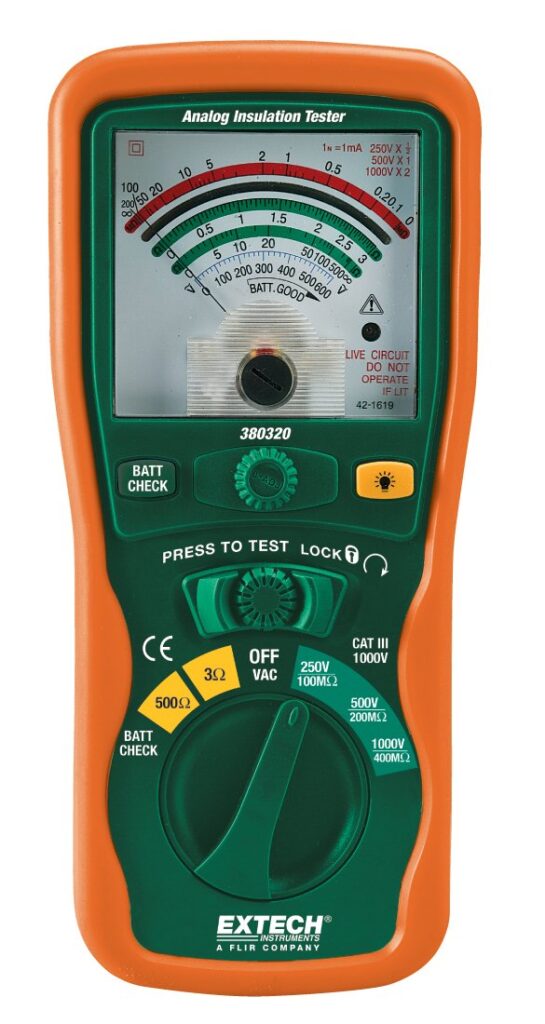
Salient features:
- It is analog in nature
- Light weighted that is 550grams
- It measures 400MΩ resistance at 1000V.
- Low consumption of battery
- Multi-layer reading display gives many results simultaneously
In a short summary, the Extech 380320 (Amazon link) is a simple tool. It measures voltage, low resistance, high resistance, and high voltage. This multitasks instrument is available at the lowest possible price for an insulation resistance tester.
3. Reed Instruments R5600
Model R5600 is manufactured by Reed Instruments: a well known player in instrumentation. It is digital and simple. Accuracy is high and readings are user friendly. It gives 4 digits of value to reduce error.
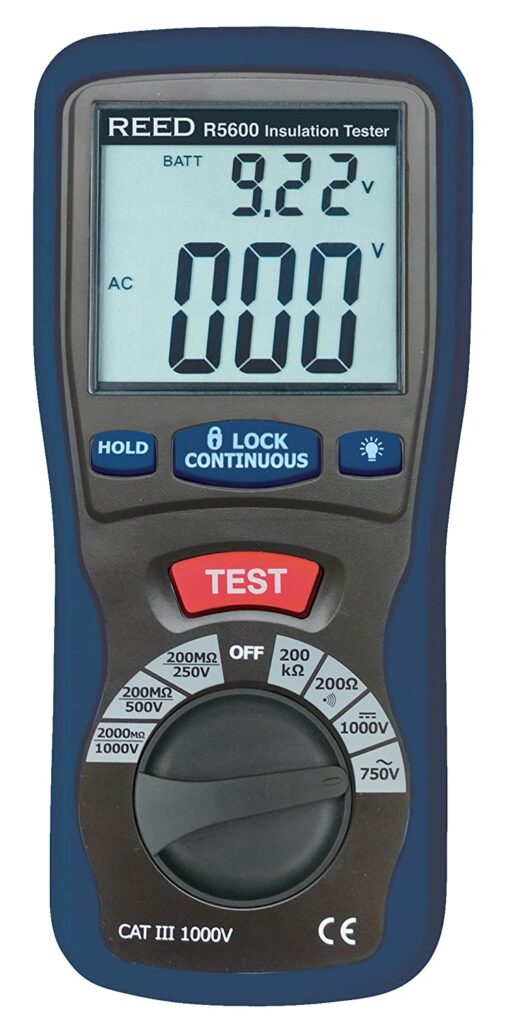
Salient features:
- It is battery powered with long-time use.
- It measures 2000MΩ at 1000V, which is quite impressive
- It is light in weight that is 1 pound (~453 grams)
- Low resistance can also be measured by using this model
- A warning buzzer and LED for night-use is additional to basic functions
In a short summary, the Reed Instruments R5600 (Amazon link) is equally popular among HVAC Technicians, research engineers, and students. It is widely known for its accurate results in research. User friendliness helps to promote its quality.
4. AEMC 2126.53
This model is digital in nature. It is designed by AEMC: a famous name in HVAC. It is known for its durability in harsh conditions and toughness in adequate situations. Moreover, it gives 4 digits of value, showing more accuracy in readings.
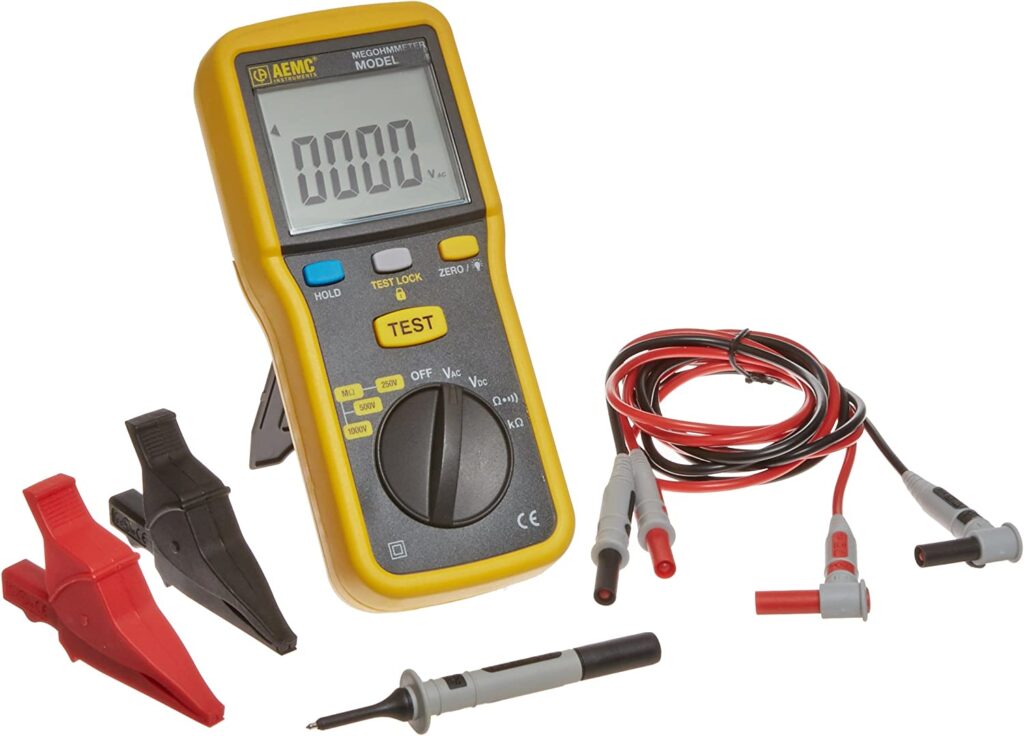
Salient features:
- It measures quality resistance at 1000V
- It is specifically designed for use inside the USA
- It is accuracy is comparatively high
- Backlight led is installed for night use
- The hold button can hold value for up to 15 min
In a short summary, the AEMC 2126.53 (Amazon link) is common among HVAC technicians. It is light, durable, resilient in harsh weather, user friendly, and easy to get. Moreover, it is equally popular for research purposes and available in research centers.
5. Fluke 1507 Digital Megohmmeter
Fluke 1507 is designed by the widely known brand fluke. It is known among engineers for its sustainability. It draws low power and works with high accuracy.
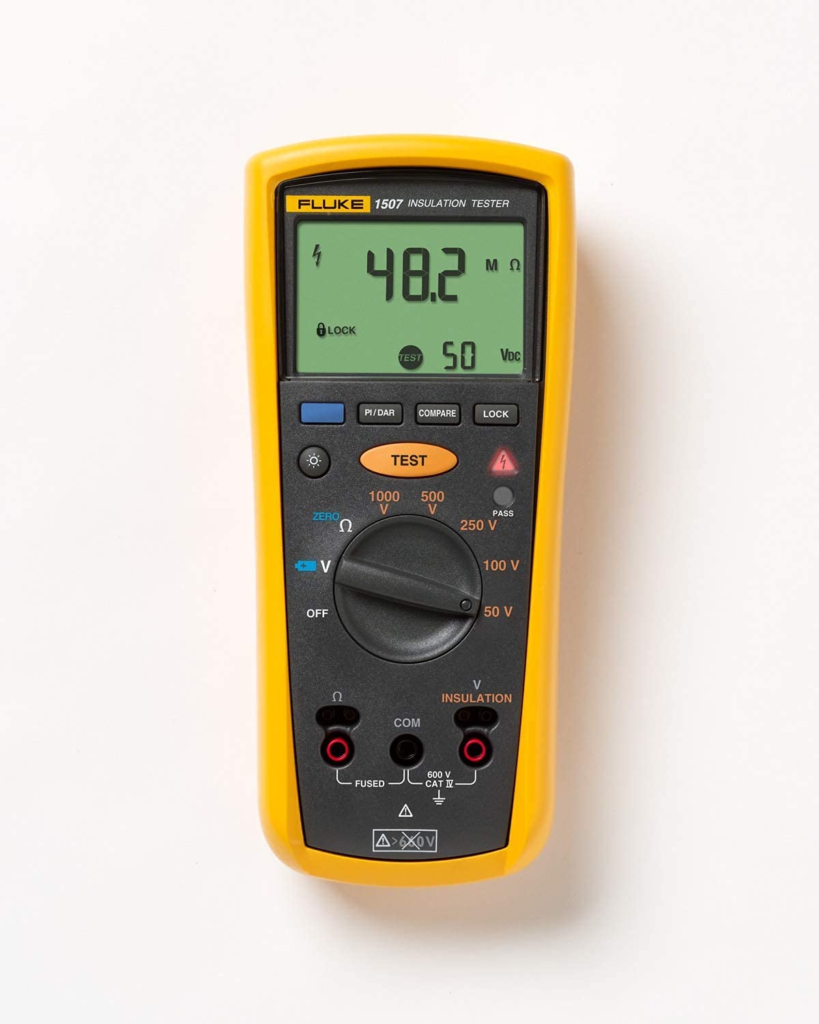
Important features:
- It ranges up to 10Giga-ohms (10000 mega-ohms) at 1000V
- Its weight of 1kg is sufficient for lab use
- A warning indicator of red led is separately installed to show the danger
- It quickly locks value while reading which helps in the calculation
- For night use, backlight-LED is available
In a short summary, the Fluke 1507 (Amazon link) is an ideal insulation resistance tester for lab use. It helps to get values with low error. Moreover, augmented options give us freedom of choice in reading. This model is available at a low price.
6. Klein Tools ET600
Klein Tools is a famous name in instrumentation. Model ET600 is widely known as a Multimeter, but it is basically Mega-ohm meter.
It is reliable and handy when it comes to detailed analysis with high accuracy. Unlike other models, it also gives the exact value of resistance up to 4000MΩ.

This model has the following distinguishing features:
- It measures the resistance of a higher value that is 4000 MΩ at 1000V
- Besides its basic design, it also measures voltage (AC/DC)
- It is installed with a warning buzzer for high value resistance
- The weight of this instrument is 1.4 pounds (~635 grams)
- In AC readings, it gives us True RMS value which is limited in instruments
In a short summary, the Klein Tool ET600 (Amazon link) is the most trusted lab instrument for engineers. It has placed itself in a good position among users. It is durable, handy, light, accurate, and simple to get data. It is available at the lowest possible price.
7. SUPCO M500
This model is simple, straightforward, and easy to use. It gives accurate data with a low response time. It is designed by SUPCO: a renowned name in HVAC (High Voltage Alternating Current).
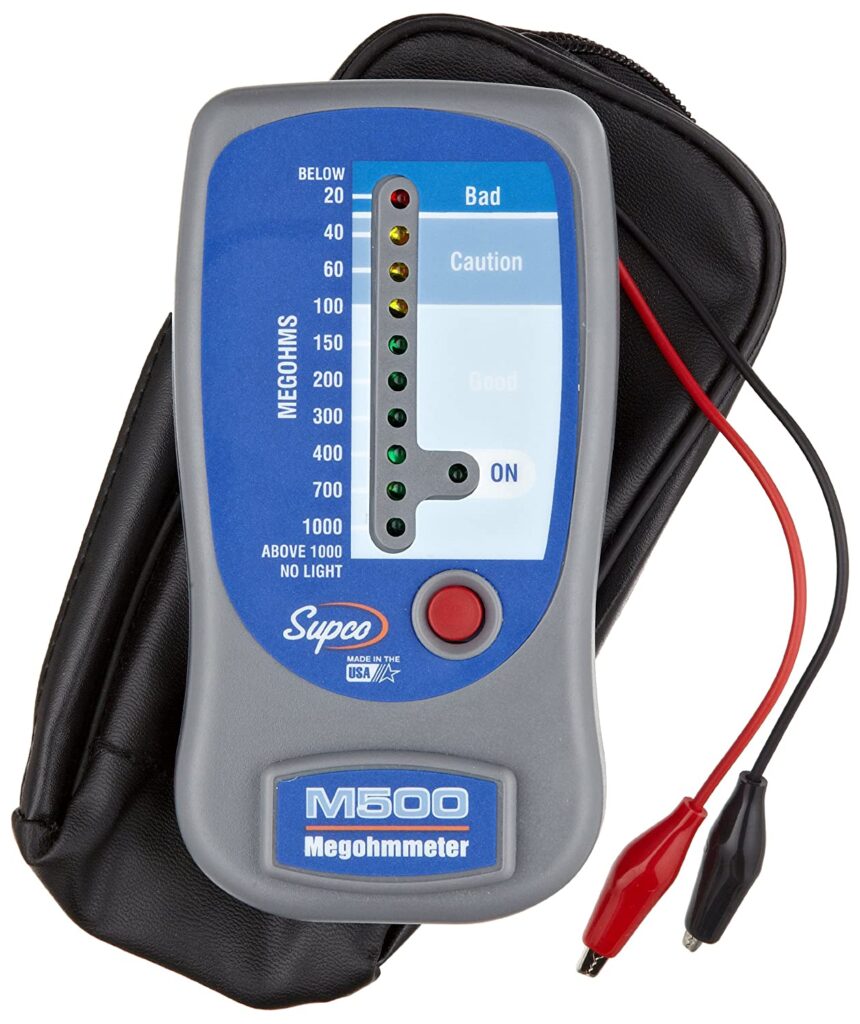
It consists of some distinguishing features like:
- LED operated reading and show a level of insulation (bad, caution, good)
- It has a proper range of 20 to 1000MΩ (Mega-ohm) at 5000V
- It is light-weighed that is 0.75 pounds (340 grams)
- Ideal instrument for HVAC
- Long-time battery operated
We suggest Supco M500 (Amazon link) to our trusted clients. It is quick in response and consumes less power. The range of 1000 MΩ is enough for our common use at 5000V. It is cheap and ideal; available at a reasonable price.
Conclusion
Long story short, the best Insulation resistance tester helps us to check the value of insulation among electrical conductors. It helps us design and saves the possibility of interference among electrical conductors.
Thus, we need a good insulation tester for this purpose. If we want to go for it, we must scrutinize a model through the:
- Ratings
- Type of current
- Brand
- Weight
- Accuracy
- Durability
- User friendliness
- And a number of functions, it provides
By thorough examination, we personally suggest Supco M500 (Amazon link) for our clients, students, technician, and engineers. It is simple to use and durable for a long time. It is accurate in results and resilient in sustainability.
Its response time is a few mili-seconds with accurate and straightforward results. It uses less power. It is one of the best choices while dealing with HVAC.
Question Answer Session
Q1: What is Megger?
Megger is a manufacturing company that manufactures good insulating resistance testers (as listed in our 7 best insulating resistance testers). Commonly, an insulating resistance tester is known as Megger. It is a common mistake that obtained the status of a trademark.
Q2: Can an object be tested simultaneously for AC and DC?
Yes, some insulating resistance testers (IRT) are installed with both functions. Just be careful in reading and selecting AC/DC before testing. Moreover, the given AC value is in RMS.
Q3: What is RMS value?
RMS (Root-mean-squared) value shows the equivalent voltage of DC, an AC can provide. For example, the alternating current might be ~310V but the RMS value for it will be ~220V. It is necessary to get acquainted with RMS value while using AC Analysis.
Q4: Why can’t we use Multimeter for insulation resistance measurement?
The multimeter is designed for low voltages, and it measures low resistances. It gives us OL (Overload) for high resistances. In contrast, IRTs work for high voltages and high resistance (commonly, up to hundreds of Mega-ohm). That’s why we can’t use a multimeter for these tests.
Q5: What is dielectric material do with insulation resistances?
Two conducting materials are separated by an insulator called a dielectric medium. This insulator affects the behavior of current on conductors. Hence, to measure this effect, we must find the insulating resistance.
Q6: Can we use IRTs for Capacitors?
We can use IRTs for High voltage capacitors. These capacitors are not commonly used in household electronics, but it is the necessary item for microwave ovens, heavy duty motors, and capacitive banks. However, for low voltages, a multimeter will do the job.
Other useful posts:
